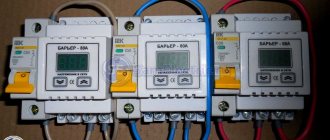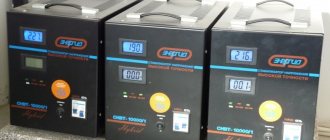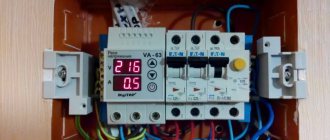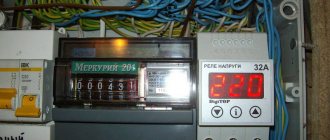To control various often very powerful circuits and mechanisms using low-current electrical signals or other influencing factors (heat, light, mechanics), special devices are used. They vary in power and design, but their meaning is the same - to turn on or off an electrical circuit when a control signal is received. The 220V relay also serves to protect the network.
Voltage relay - what is it and what is it for?
A voltage control relay is a technical device designed to protect the operation of devices and equipment connected to the electrical network from possible voltage surges, both in the direction of increasing it and decreasing it below permissible values. A decrease in voltage level negatively affects the operation of household appliances and electronics, and an increase above permissible limits can even lead to their breakdown. The voltage relay reacts to such changes and disconnects the internal distribution network of the apartment or house from external electrical networks.
Time relay with switch-on delay, DIN rail, electronic, circuits
A variety of control mechanisms are widely used to control electrical devices. We propose to consider how a simple 220V cyclic time relay works, how to assemble the device with your own hands, operating instructions, its designation and explanation, and also where you can buy the device.
Total information
A relay is an electrical electromagnetic device, which in essence is a switch; according to its periodicity it can be daily, hourly or weekly.
This type of device is used where it is necessary to control circuits with a low-power signal (with complete electrical isolation between the control and controlled conductors), where several circuits must be controlled using a single signal.
The first relays were used in long-distance telegraph circuits as amplifiers: they repeated the signal coming from one circuit and transmitted it to other circuits. It was also used to complement the operation of computers to carry out simple logical commands.
Photo – Magnetic field
Sometimes an electromechanical relay is a kind of "shock absorber" attached to the armature, which prevents immediate full movement if the coil suddenly comes into voltage or, on the contrary, is de-energized. This addition gives the relay the property of delayed operation time. A mechanical time delay relay can be used to delay the armature from energizing the coil, de-energizing, or both.
Video: how to make a time relay using one transistor
Principle of operation
Electric current through conductors creates a magnetic field at right angles to the direction of electron flow. If the conductor is coiled into a coil shape, the magnetic field produced by the relay will be oriented along the length of the coil. The greater the current, the greater the strength of the magnetic field, as shown by the electrical diagram of operation:
Photo – Scheme
The inductors respond to changes in the current state of the relay due to the energy stored in the derived magnetic field.
When we build a transformer with two inductors around a common iron core, a magnetic field is used to transfer energy from one coil to the other.
However, there are simpler and more direct ways to apply electromagnetic fields than in a variety of devices. The magnetic field created by a current coil can be used to apply mechanical force to any magnetic body.
Photo - Coil diagram
If we place a magnetic sensor near such a coil for the purpose of moving an object, then when the coil with electric current is activated, we get an electromagnet. A moving magnetic needle is called an armature; most needles are moved by direct (DC) or alternating (AC) current applied to a voltage coil.
Advice
The polarity of the magnetic field does not matter in attracting the iron core. Solenoids can be used to electrically open door latches, control valve operation, move robots and their limbs, and drive electrical switch mechanisms.
But, if a solenoid is used to actuate a set of switching contacts, it is called a trip relay .
Relays are extremely useful when there is a need to control large amounts of current and/or voltage with a small electrical signal.
A relay coil that produces a magnetic field can conduct fractions of a watt of energy, while the contacts (closed or open to the magnetic field current) can conduct hundreds of watts of load energy.
Essentially, the relay acts as a binary on/off amplifier.
In the circuit shown, the relay coils are energized by a low voltage source (12 VDC) while the SPST contact receives high voltage circuit current (480 VAC).
It is likely that the current required to power the relay coil will be hundreds of times less than the current level.
Typical relay coil currents are well below 1A, while industrial relay contacts have ratings of around 10amps.
One relay coil can be used to drive more than one set of contacts. These contacts can be normally open, normally closed or any combination of the two or more. Relay contacts can be made of metal alloy, mercury, or even magnetic reed, just like other types of switches.
Design
A simple two-channel electromagnetic relay consists of a coil of wire wrapped around an iron soft core, an iron armature that provides low resistance to magnetic flux, a movable iron pointer, and one or more sets of contacts.
Principle of operation
The operation of a monitoring device of this type is based on measuring voltage values in the external supply network. When the values fall below the specified values or exceed the upper set limit, the relay opens its power contacts, thereby disconnecting the consumer’s network from the external power supply.
Connection diagram to a single-phase power supply network for an apartment or house
After a certain time period, the device automatically closes the power contacts and supplies power to the internal power supply network. To prevent cyclic restarts of the power section, the design of the device includes a turn-on time delay (delay interval), which can be set by the manufacturer or set manually. If the voltage level after disconnection does not reach the specified values, the device will not close the power contacts.
Intermediate relay 220V
Such a device is considered an auxiliary device and is used in various automatic circuits, as well as in control. The purpose of the intermediate relay is to disconnect the contact circuits of individual groups. It can also simultaneously turn on one circuit and turn off another.
There are two types of switching circuits for 220V intermediate relays:
- Based on the shunt principle. In this case, all supply voltage is supplied to the relay coil.
- By serial type. Here the winding of the mechanism with the switch coil is connected in series.
In the relay circuit, depending on its design, there may be up to three windings on the coils.
Device management and additional features
To control the operation, buttons or adjusting screws are placed on the outer surface of the housing, through which the upper and lower limits of the operating voltage values are adjusted.
Appearance of the Zubr brand relay with explanation of the control buttons
In addition, the device can be equipped with a light indicator for the presence of voltage in the internal network, a digital display displaying the current value of this parameter, and also have a memory function that allows you to display the parameters of the last shutdown performed.
Classification and types
Voltage relays are classified according to:
- location and installation;
- number of phases of the electrical network.
By connection type
There are three ways to place and install such devices, which determine the type of their inclusion in the electrical network:
- Voltage relay plug-socket.
Model "RN-116" plug-socket type
This type of placement allows you to control the voltage supplied to only one consumer connected to the plug-socket unit. In this case, the voltage supplied to other load elements is not monitored or controlled.
- Extension voltage relay.
This type of electrical equipment is an extension cord equipped with a built-in control relay. When using it, you can power a group of household appliances and devices, thereby protecting them from power surges.
In this case, the main limitation of use will be the maximum permissible power of the connected devices, determined by the value of the load current.
Model "Bison P616Y"
- Voltage relay for DIN rail mounting.
This is the most functional option for placing such protection elements and is due to the fact that a relay of this design is installed in the main distribution board (MSB), input distribution device (IDU) or lighting panel, thereby making it possible to protect the entire electrical network of an apartment or country house. The main condition for choosing when installing in this way will be the correspondence between the power of the device and the total power of the connected load.
Related article:
What is a relay , areas of application, circuit diagram of an electromagnetic product, main technical characteristics, main types and their purpose, manufacturers and models - in our material.
By number of phases
Everyone knows that electrical networks are single-phase and three-phase, respectively, and electrical devices are designed for these voltage classes. A single-phase control relay is a device designed to operate in electrical networks for various purposes with an operating voltage of 220 Volts. The design and methods of placing such protective equipment are discussed above.
Model "RNPP-301", mounted on a DIN rail
Three-phase models are installed in the ASU or main switchboard of a country house (cottage), if their power supply circuit provides for connection via a three-phase circuit with a voltage of 380 Volts.
In this case, it is possible to protect the entire internal power supply network, as in the case of using a voltage relay installed in the lighting (apartment) panel.
Main technical characteristics
Most relays operate at voltages ranging from 50 to 400 watts. Such a large interval allows the device to be used in both single-phase and three-phase networks, as well as to flexibly configure the required response limits of the protective device. The main technical characteristics include:
- supply voltage;
- maximum load power;
- maximum load current;
- degree of protection on the body;
- switching resistance of relay contacts;
- load shedding time;
- maximum cross-section of connected wires;
- turn-on delay time;
- Dimensional parameters.
What you need to know when choosing
The main parameters that influence the choice of a particular model of protective device are:
- technical characteristics - phase pattern and maximum permissible current;
- type of control – electromechanical or digital;
- execution option - type of installation and design of the device (plug-socket, extension cord, DIN rail);
- availability of additional features;
- reliability – device brand and manufacturer brand.
Monitoring relay with electromechanical control type
The maximum permissible current is the most important technical parameter that determines the possibility of using a voltage relay to connect a particular load. When choosing such a protection device, you should take a model one step higher (according to the standard current series) than the circuit breaker installed in this section of the electrical network. So, if the circuit breaker has a current setting of 16 Amps, then the protection relay must be rated at 25 Amps. This is due to the fact that the value indicated on the protection relay reflects the operating current values, and not the maximum permissible in the operation mode. The type of control determines ease of use, as well as the ability to visually display the current voltage value in the electrical network. Electromechanical models are equipped with trimming resistors, with the help of which the upper and lower response thresholds are set.
Model "Digitop Vp-32a" with digital control type
Digital analogues have an LED screen on which you can monitor voltage values online, and the response thresholds are adjusted using buttons. Additional features that monitoring relays can be equipped with include: indicators for the presence of voltage in the load circuit and a temperature sensor, as well as various mounting options available on a specific model (DIN rail, self-tapping screws, etc.).
Related article:
Which 220V voltage stabilizer to choose for your home. You are familiar with the problem of power outages, which manifests itself in blinking light bulbs. In the article we will talk about how to choose the right 220 V voltage stabilizer for your home in order to forget about this problem once and for all?
How to connect - general recommendations
In the case of using models such as “plug-socket” voltage relay and “extension cord” voltage relay, there are no difficulties with connecting them, because For this purpose a normal plug connection is used.
Placement in a recessed type lighting panel
When using a relay installed in a distribution panel or cabinet, certain rules must be followed to facilitate the maintenance and operation of such devices:
- The relay is always installed after the meter.
- It is recommended to install a protection device in front of the relay with a current setting lower than the relay used (20–30%).
- The presence of additional protective equipment (RCDs, stabilizers, etc.) will make operation safer.
- The location must be chosen in such a way that it is possible to configure the device, as well as visually monitor its operation.
Placement in an apartment building
Operating principle
You can clearly see the action of a relay using the example of an electromagnetic one. Such a mechanism contains a winding with a steel core and a group of contacts that move movably, closing and opening the circuit. A control current is supplied to the core coil. This current, according to the law of electromagnetic induction, creates a magnetic field in the core, which attracts the contact group, and it closes or opens the electrical circuit, depending on the type of relay.
Connection diagrams and settings for popular models
Domestic and foreign manufacturers of electrical devices produce various models of voltage relays designed for home use.
The most popular brands in this product category are Z ubr and RN , UZM and ABB , as well as DigiTop .
Zubr brand devices
This brand of devices is produced by Donetsk, its assortment includes models installed on a DIN rail, as well as types of voltage relays “plug-socket” and “relay-extension”. Models designed to be plugged into a plug socket are designed for a rated current of 16 Amps, while others are designed for various values: 16/25/32/40/50/63 Amps, which corresponds to the standard scale of permissible current values.
Protection and control devices of the Zubr brand are reliable and easy to use
The correspondence of the rated and maximum permissible current for relays of the “ZUBR” (RBUZ) is given in the following table.
| Image | Model | Rated current, Ampere | Maximum permissible current, Ampere |
| D16 | 16 | 25 | |
| D25/D25t | 25 | 30 | |
| D32/D32t | 32 | 40 | |
| D40/D40t | 40 | 50 | |
| D50/D50t | 50 | 60 | |
| D63/D63t | 63 | 80 |
Models designed for DIN rail installation have three control buttons:
- upper - to set the maximum response threshold;
- lower – for setting minimum values;
- medium – to set the restart time.
The factory default restart time is 3 seconds. The device’s memory remembers all the set values, and even during long power outages, all settings and settings will be saved. The connection diagram for the voltage relay of the Zubr series is shown in the following figure.
Connection diagram for single-phase voltage control relay series “ZUBR” (RBUZ)
Distinctive features of the models from this manufacturer are:
- response voltage adjustment step – 1 Volt;
- re-activation time adjustment step – 3 seconds;
- the presence of the letter “t” in the model designation indicates the presence of thermal protection against internal overheating;
- The relay width is 53 mm, which corresponds to three modules on a DIN rail.
Thanks to its convenient mounting and the ability to visually control values in real time, the brand is well-deservedly popular among professionals and ordinary users, as evidenced by their reviews.
Review of the “ZUBR D63” model:
More details on Otzovik:
Another review about the “ZUBR D63” model:
More details on Otzovik:
For clarity, let’s see what indicators and elements an average home voltage stabilizer consists of.
Appearance of the voltage relay brand RN-113 indicating the control elements
RN series
Devices of this brand are produced by NEKM LLC (Russia) and are sold under the TDM ELECTRIC brand. A distinctive feature of these relays, and these are models such as RN-111, RN-113 and RN-111M, is that they are designed for a rated current of 16 Amperes. If it is necessary to connect a larger current load, it is necessary to install an additional contactor, in the control circuit of which these relays are included. The connection diagram for the RN-113 voltage relay is shown in the following figure.
Scheme for connecting a relay of the RN-113 brand to an electrical network with a load of varying power
The letter “M” in the model designation indicates the presence of a light indicator panel. The measurement error is 1−2 Volts from the actual values.
Review of the RN-113 model:
More details on Otzovik:
Another review about the RN-113 model:
More details on Otzovik:
UZM series
This line of voltage relays is produced by Electrotechnical (Russia), it includes models UZM-51M, UZM-50M and UZM-16.
Appearance of the UZM-51M model with designation of control elements and settings of operating modes
Distinctive features of this series of devices are:
- lack of digital display;
- to adjust operating modes, rotary controls are installed in steps of 5 Volts to set the upper limit of operation and 10 Volts for the lower limit;
- the operating status of the relay is indicated by light indicators;
- restart has only two settings - 10 seconds and 6 minutes;
- The width of the relay is 35 mm, which when installed on a DIN rail corresponds to two modules.
The UZM-51M connection diagram is very simple, which is another feature of this model
Devices brand "DigiTOP"
The DigiTOP brand belongs to the Ukrainian company, whose product line includes various devices for monitoring and measuring various electrical parameters (current, voltage, power, etc.). In the category of voltage control relays, there are single-phase and three-phase models with different current characteristics, designed for installation on a DIN rail, as well as models of the socket-plug relay type.
Voltage relay brand "DigiTOP"
Models designed for installation on a DIN rail are available in several modifications:
- V-Protector.
Distinctive features of this modification are:
- protects only from power surges;
- have built-in thermal protection;
- Installation is only possible indoors, because the operating temperature range starts from +5˚С.
- VA-Protector.
This series differs from other modifications and models from other manufacturers in that it combines voltage and current relays. In addition, the distinctive features of the series are:
- The current values of voltage and current are displayed on the screen;
- if the current load is exceeded, the relay turns it off;
- in short-circuit mode, shutdown occurs in 0.04 seconds, in long-term overload mode - after 10 minutes of operation in this mode.
Diagram for connecting the voltage relay “DigiTOP”
Review of the “DigiTOP V-protector” model:
More details on Otzovik:
Another review about the “DigiTOP V-protector” model:
More details on Otzovik:
ABB brand devices
The world-famous brand ABB (Asea Brown Boveri Ltd) belongs to a Swedish-Swiss company specializing in the production of electrical equipment and information technology.
Single-phase voltage monitoring relay ABB CM-ESS.2S
Among the models of low-voltage control and protection devices intended for domestic use, there are single-phase ABB voltage relays for operation in different operating modes:
- ABB CM-EFS.2S - with a time relay and a power supply of 24-240 V, AC or DC;
- ABB CM-ESS.1S – designed for operation in different regulated voltage ranges (3−30.6−60, 30−300, 60−600 V), in networks with a voltage of 24−240 V AC or DC.
Connection diagram and functions of voltage relay switches CM-ESS.1S and CM-EFS.2S
At what price to buy a 220 V voltage relay for the home - price review
220 V voltage relays for the home can be bought in stores and retail chains specializing in the sale of electrical equipment, as well as on the Internet, where a fairly wide selection of similar products is also available. Prices for the 220 V voltage relays discussed in this article for the home are shown in the following table, as of the second quarter of 2022, when sold through online resources.
| Image | Model | Average cost (as of May 2022), rub. |
| "ZUBR" (RBUZ) D16 | 1640 | |
| "ZUBR" (RBUZ) D25/D25t | 2000 | |
| "ZUBR" (RBUZ) D32/D32t | 2300 | |
| "ZUBR" (RBUZ) D40/D40t | 2600 | |
| "ZUBR" (RBUZ) D50/D50t | 2900 | |
| "ZUBR" (RBUZ) D63/D63t | 3200 | |
| "TDM ELECTRIC" RN-101M | 2620 | |
| "TDM ELECTRIC" RN-111M | 1800 | |
| "TDM ELECTRIC" RN-102 | 1600 | |
| "Meander" UZM-51M | 2620 | |
| "Meander" UZM-50M | 1800 | |
| "Meander" UZM-16 | 1600 | |
| "DigiTOP" Vp-16AS | 1900 | |
| "DigiTOP" MP-63A V-Protector | 5020 | |
| "DigiTOP" VA-32A VA-Protector | 2770 | |
| "DigiTOP" VA-63A VA-Protector | 3790 | |
| "ABB" CM-EFS.2S | 6463 |
The variety of offers on the electrical products market allows you to choose a model in accordance with the technical requirements for these devices in different price ranges.











